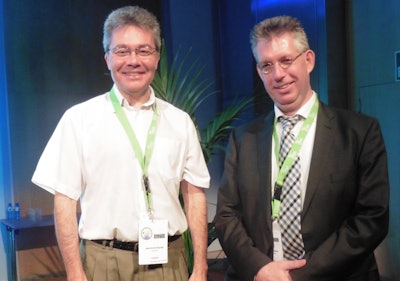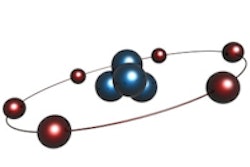
Randomized controlled trials (RCTs) play a central role in the introduction of new medical devices or drugs. But whether RCTs are needed for the rollout of proton therapy is a subject of much contention. The question was debated at the 3rd European Society of Radiotherapy and Oncology (ESTRO) Forum in Barcelona, Spain, where Dr. Dirk De Ruysscher, PhD, from KU Leuven in Belgium took on the onerous task of arguing that randomized trials are obligatory for proton therapy.
"I often face criticism that we don't have randomized trials in proton therapy," De Ruysscher told the attendees. He emphasized that he was not going to discuss whether protons spare more normal tissue in central nervous system and cranial treatments, or avoid second malignancies in pediatric cases, as these facts are indisputable. But for treatments of other sites, he said, trials are necessary.
 For and against: Dr. Dirk De Ruysscher, PhD, and Dr. Johannes Langendijk, PhD.
For and against: Dr. Dirk De Ruysscher, PhD, and Dr. Johannes Langendijk, PhD.For reimbursement of many medical devices and drugs, level 1 evidence -- derived from randomized trials -- is a necessity. "So why would we lower the bar for proton therapy?" De Ruysscher asked. "We should come out of our radiotherapy comfort zone and become more critical."
So why is the field so reluctant to perform RCTs? One factor may be that, unlike the case when new drugs are introduced and the pharmaceutical companies perform their own trials, in proton therapy, it's down to the user to take the risks. It's also likely that the lack of funding for trials plays a role.
De Ruysscher cited some instances in which RCTs may not be needed. For example, if a condition has an established and predictable natural history, or there is no appropriate control treatment to use. But cancer is not a predictable disease, and controls are very much available.
Alternatively, if the magnitude of a treatment's benefit is so large that interpretation becomes unambiguous, then RCTs are not essential. De Ruysscher suggested a ratio of 10-to-1 as strongly suggestive of a genuine therapeutic effect. "It must be clear that there is a real and large benefit," he explained. "But published evidence does not clearly show that protons offer a clinical benefit over photons."
De Ruysscher concluded that for common cancers, "we need to perform RCTs, which may be small, to prove that our model-based approach works. If not, the battle to obtain and sustain reimbursement will likely be lost."
The case against
Arguing against the motion was Dr. Johannes Langendijk, PhD, from University Medical Center Groningen in the Netherlands. He started with a question: "How many radiation technologies have been introduced into clinical practice based on RTCs so far?" And the answer: "Not any."
Langendijk pointed out that in around 85% of cases, proton therapy is used to prevent complications and minimize the risk of second tumors. Proton plans can deliver less dose to normal tissue, and radiation oncologists exploit this fact to employ the ALARA (as low as reasonably achievable) principle. "There is a huge body of evidence showing that increasing dose to normal tissue will lead to more biological damage and more side effects," he explained. "So why should I expose my patients to potentially avoidable hazards?"
He shared his thoughts on why RCTs are not suitable for comparing proton technologies with existing treatments. One problem is the rapid evolution of proton therapy technology: from passive to scanned delivery, to the emergence of image guidance, and -- at some point in the future -- real-time range verification. With average first treatment-to-publication times of 10.4 years for radiotherapy RCTs and some radiation-induced complications taking more than 10 years to appear, published trial data may well refer to outdated technologies that are no longer used for treatment.
Another issue is the limited access to proton facilities, particularly in Europe, which could lead to very low accrual rates. And then there's the cost: With each study requiring around 7 to 10 million euros, funding to carry out an RCT for one indication becomes highly unlikely.
Finally, Langendijk emphasized the ethical issues. He cited an example in which an intensity-modulated radiotherapy (IMRT) plan would deliver a dose of 23 Gy to the heart, while an intensity-modulated proton therapy (IMPT) plan for the same case would only deliver 6.3 Gy. This dose reduction equates to a 10% decrease in the patient's risk of a major cardiac event. "Randomized trials were intended to evaluate the benefits of therapeutic interventions in terms of efficacy and safety," he said. "We are not talking about efficacy; we're talking about prevention of side-effects."
Instead, Langendijk proposed the use of a prediction model for evidence-based selection of patients who will benefit most from proton therapy. This involves development of normal tissue complication probability (NTCP) models, which are applied to each patient to calculate their individual ΔNTCP. This parameter represents the difference in NTCP between proton and photon treatments, derived from the respective doses delivered to relevant organs-at-risk (OARs).
The ΔNTCP data are then applied to select patients who will most likely benefit from protons, based on a chosen threshold. Langendijk presented an example plot for 50 patients, in which a threshold of 5% ΔNTCP for grade III or higher side effects resulted in 27% of patients being selected as eligible for proton therapy.
"Proton therapy will be mainly applied to reduce side effects, with similar tumor control, and the risk of side effects can be described using multivariable NTCP models," Langendijk concluded. "The model-based approach is an excellent alternative to RCTs, allowing for more individualized patient selection."
 The audience votes.
The audience votes.Parting shots
De Ruysscher returned to the podium. He argued that the proposed model selects patients on the basis of a "snapshot," and does not account for factors such as uncertainty in the relative biological effectiveness (RBE) of protons in the Bragg peak. In addition, range and setup uncertainties, combined with anatomical changes such as weight loss and tumor shrinkage during a treatment course, can lead to increased dose to OARs.
Even when replanning is performed, many uncertainties remain that may affect the NTCP model. De Ruysscher pointed out that while the ethics of performing RCTs are often alluded to, treating patients without a validated NTCP model also may be questionable. "The NTCP model can be trusted for photon treatments but not for proton therapy," he said. "Using a model-based approach without knowing that it is valid for protons, could prove a huge mistake."
He emphasized that, for use with common cancers, these models must be validated prospectively for protons and then proved to be beneficial in a randomized trial. "Only this will give us scientific credibility," he said. "If we are confident in these models, why not prove it and the debates will stop!"
Langendijk retook the stage. He maintained that RCTs do not necessarily represent the highest level of evidence. He cited the U.K.'s Centre for Evidence Based Medicine (CEBM), which assigns a prediction model externally validated in an independent population as level 1a evidence, compared with level 1b for an individual RCT. "Dirk De Ruysscher said, 'Why lower the bar for proton therapy?' But this is not true; we do not lower the bar. The level of evidence is even higher," he claimed.
Langendijk also pointed out the loss of personalization that occurs following an RCT. If a trial is positive, all patients will receive proton therapy, if it is negative, none will. "The model offers the possibility of an individualized approach, which is lost with RCTs. And to develop multivariable NTCP models, prospective cohorts are the best design," he said, emphasizing the far higher accrual rates associated with a population based prospective cohort study.
He noted that the NTCP model-based approach -- which has now been adopted by the Dutch health authorities to select patients for proton therapy -- can also be employed to validate the clinical benefit of protons compared with photons. "RCTs are not obligatory for proton therapy when aiming to reduce side-effects," Langendijk said. "The model-based approach is the most optimal study design for testing the validity of new radiotherapy technologies."
The debate concluded with a show-of-hands vote. The majority of the audience voted against the motion -- believing that randomized trials are not obligatory for proton therapy and that a model-based approach could indeed provide the optimal approach.
© IOP Publishing Limited. Republished with permission from medicalphysicsweb, a community website covering fundamental research and emerging technologies in medical imaging and radiation therapy.



















